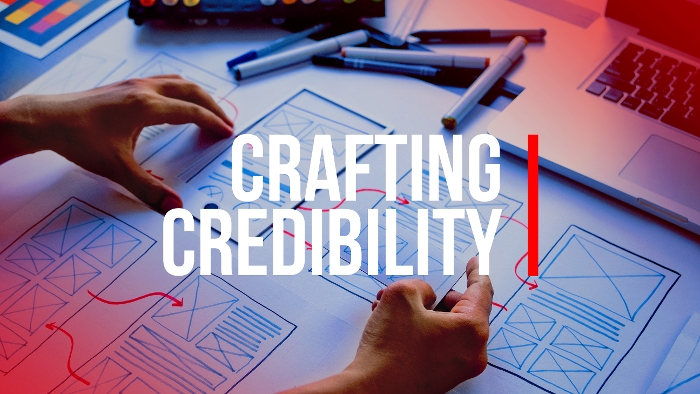

Blog: Crafting credibility

In the world of corporate design, image altering and Photoshop are part of the digital tool box that can help paint a brand's visual narrative. For graphic designers, enhancing images is an integral part of our craft. Our challenge lies not just in creating visually appealing content - but in understanding when to enhance and when to tread lightly, striking the balance between authenticity and aspiration. When done strategically, enhancements contribute to the brand’s ‘Halo Effect’, casting a radiant glow on a brand's credibility. However, the ethical waters become murky when image altering veers into deception. Misleading representations not only compromise authenticity but can also take the shine off the hard-won positive halo.
At its core, the Halo Effect is a psychological concept where the first visual impression, influence our perception of an entire person or a brand. The brand then exudes credibility, and consumers are more likely to respond positively to it, and to forgive shortcomings. From polishing visual elements to refining the overall aesthetic, our goal is to create a positive impression.
.png)
Image: https://sproutsschools.com
Striking a balance between enhancement and truth is paramount. Serious problems arise if a person’s image has been altered without consent, because of the highly personal nature of physical appearance.
Channel Nine’s recent ‘AI’ edits to a graphic featuring Victorian Animal Justice Party MP Georgie Purcell is a great example. An altered image of her involved enlargement of her breasts, turning her dress into a crop top, as well as other micro tweaks to her appearance. This image then appeared as a title screen on the nightly news. While the blame was attributed to AI, it should be noted that a human should have, and most likely was behind the wheel, initiating, mediating, adjusting and approving the process.

Many clients want to be presented in the best possible light and achieve their own personal halo effect, which ultimately contributes to their businesses’ overall halo. People often pull me aside, and in a half-joking, half-serious way quietly say, ‘feel free to’…. hide this, or remove that or adjust my…. you name it! But what happens when you haven’t had direct contact with the person whose image you have loaded up into Photoshop?
My rule of thumb is, if something could have been changed recently, in real life, such as hair, lighting or clothing then it’s acceptable to adjust, using my best judgement as a professional designer. In almost all cases, this is what the person in the image would expect. Or, if the timing was out by a couple of weeks, which would have affected how some aspect of the image appeared, then it would be reasonable to adjust that. For example, an unfortunate blemish may have appeared in the past few days, so I would be happy to assist by photoshopping it away. On top of that, if the client requests any stronger alterations, I’m happy to oblige, as long as it’s puts their company in a favourable light and isn’t misleading.
Understanding the interconnectedness of graphic design, particularly image retouching and the Halo Effect, is essential. Every stroke of the digital brush should align with the brand's values, contributing positively to its perceived credibility. It's not just about visual appeal but also about building trust in the corporate arena.
As graphic designers in the corporate realm, our role extends beyond pixels and colour palettes. It's a delicate balance between enhancing visual appeal and preserving the authenticity that underpins a brand's credibility. It must contribute to the positive Halo Effect that elevates corporate visuals to a realm of trust and admiration.
Hughes | Graphic Designer
Recent News
- Blog: Caitlyn's work experience at Hughes
- Blog: Navigating the changing media landscape
- $48M affordable housing hub revives beachside site
- Covid success story: SA digital transformation start-up expands interstate
- Industry leader Mark Smith appointed National Pharmacies CEO
- Mellor Olsson appoints new CEO
- Indonesia AirAsia touches down in Adelaide, enabling affordable connectivity across Asia via Bali
- Playgroup reimagined: Elders and children connect at ACS's Aboriginal aged care home
- Apartment living reaches new heights with $120 million Parkline development topping out
- A Fresh Take on Strawberries: Premium Packaging that Looks as Good as it Performs
- Paper & board packaging leader unboxes new global HQ in Adelaide
- Lutheran Homes Group brings its high-quality aged care to regional Victoria in historic expansion
- Blog: The growing AI threat - what it can mean for your brand and reputation
- CH4 Global named as one of the world’s top Sustainable Development Goal leaders
- Scotch AGS Vietnam’s inaugural SACE graduates go global
- Gen Z and the future of AI
- Qantas international services return to Adelaide
- Blog: Let’s get (a)political: all you need to know about elections and public relations
- The world’s most valuable dog toy revealed in the lead up to Guide Dogs Day
- Skytrax names Adelaide as best regional airport in Australia & Pacific region








